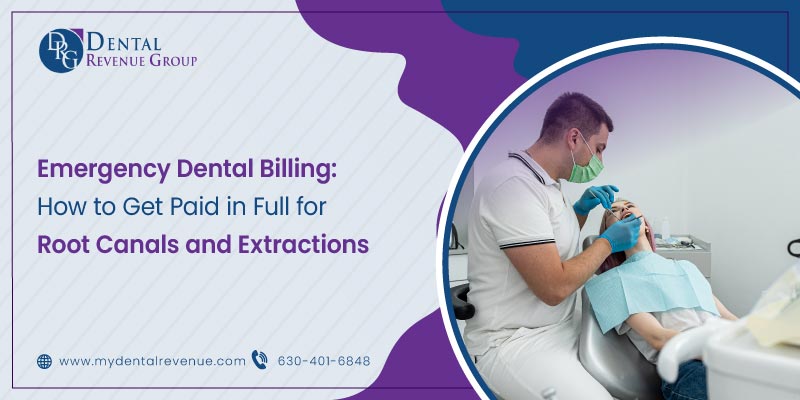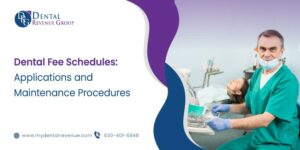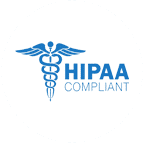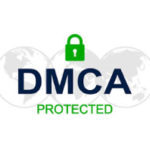Emergency dental procedures like root canals and tooth extractions often come unexpectedly and involve significant costs. Unlike preventive cleanings and checkups, emergency treatments alleviate pain, halt infection, and restore critical oral functions. This guide covers how dental offices can maximize insurance reimbursement and patient collections for emergency procedures. We’ll explore proper claim submission, accurate coding, pre-authorizations, negotiating discounts, and best practices for following up on unpaid claims. Dental practices can obtain full payment for emergency services critical to patient health and wellbeing with the right billing and collections approach. Proper reimbursement allows dental offices to continue providing urgent care and expands treatment access for those in need.
Tips To Get Paid for Emergency Dental Billing
Getting paid for emergency dental billing involves several key steps to ensure timely and accurate reimbursement. Here’s a detailed guide to help you navigate the process:
Submitting Claims
Submitting dental claims is crucial for getting appropriately paid on time. Emergency dental procedures like root canals and extractions often come unexpectedly, but dentists must follow proper claim submission protocols.
- Claims should be submitted to the dental insurance provider as soon as possible after treatment. Most dental insurance companies require claims to be submitted within 12 months of the date of service. Submitting a claim later than 12 months will likely result in a denial.
- Claims for emergency procedures like root canals or extractions should be submitted within 30 days of the procedure. Submitting them allows the insurance company to process and reimburse them more rapidly.
- If the dental office is waiting to coordinate benefits from another insurer, the claim can be held for up to 180 days before being submitted to the secondary insurer. However, prompt submission is still best.
- Claims should be submitted electronically whenever possible, allowing faster processing. Most clearinghouses and dental software systems can submit electronically.
- If submitting on paper, use the standard ADA dental claim form. Paper claims take longer to process. Send forms promptly after treatment.
- Follow up with the insurer if you have not received an Explanation of Benefits (EOB) within 30 days of submitting the claim. EOBs detail how the claim was processed.
The bottom line is that prompt claim submission optimizes the likelihood of full and timely reimbursement from insurers. Don’t delay in sending the paperwork, especially for emergency procedures.
Coding Procedures
Proper coding is crucial for getting insurance claims paid in full. For emergency dental procedures like root canals and extractions, providers must use codes that accurately reflect the services performed. Some essential coding tips include:
- Bill emergency evaluations under D0140 limited oral evaluations. This evaluates a patient reporting a dental emergency, like trauma or acute infections.
- For emergency palliative treatment to relieve dental pain, use code D9110. This covers minor procedures like opening pulps or applying sedative fillings.
- Root canal therapy should be coded as endodontic treatment. For anterior teeth, use D3310, and for bicuspids, use D3320. Molars are coded as D3330.
- Extractions are coded based on the tooth. Single extractions of erupted teeth are D7111 for permanent teeth and D7140 for primary teeth. Surgical extractions of erupted teeth use D7210 and D7220.
- Use code D7250 for the removal of residual tooth roots. This is for extractions where the crown is gone, but roots remain.
- For alveoloplasty in conjunction with extractions, use D7310 or D7311. This covers the reshaping of the bone.
- Billing for related services like x-rays, exams, or anesthesia may be required for accurate payment. Use standard CDT codes for these additional procedures.
Properly coding emergency dental procedures shows the complexity and justification for the treatment. This helps demonstrate medical necessity to insurers and avoid claim denials or down-coding.
Pre-Authorizations
Getting pre-authorization from the patient’s insurance provider is crucial for ensuring complete and timely payment for emergency dental procedures. Here are some tips on obtaining pre-auth:
- Check the patient’s insurance card for information on pre-authorization requirements. There may be a dedicated pre-auth department listed.
- Call the number on the insurance card and speak to a representative to find out specifics on pre-auth for emergency dental work. Inform them of the emergency nature of the procedure.
- Have information ready, like the patient’s ID number, procedure codes, projected costs, etc., to expedite pre-auth.
- Get pre-auth reference numbers during the call and note the names of representatives. This creates a paper trail proving you obtained pre-auth.
- Follow-up by faxing or emailing any required information to the insurance provider. Include copies of pre-auth reference numbers.
- If pre-auth is denied, appeal immediately in writing, citing the emergency status of procedures. Provide medical records if needed.
- For patients who are unconscious or otherwise unable to provide insurance information, work quickly to identify their coverage and obtain retroactive pre-auth.
Securing pre-authorization before emergency dental procedures will get claims processed faster and prevent denials or delays in payment. Be proactive with insurance providers and persistent on appeals to maximize reimbursement.
In-Network vs. Out-of-Network
Being in-network or out-of-network with insurance plans greatly impacts how much you’ll get paid for emergency dental procedures. Here are some key strategies based on your network status:
If You’re In-Network:
- Check the patient’s insurance plan to confirm you’re in-network and contracted rates. This ensures accurate fee schedules.
- Bill the insurance company directly. As a contracted provider, they are required to pay you the negotiated rate.
- Collect only the patient’s copay/coinsurance amount. You cannot balance the bill for more than the contracted rate.
- Appeal denials through the insurance company’s provider dispute resolution process. Leverage your contract for improved payment.
If You’re Out-of-Network:
- Confirm if the plan has out-of-network dental benefits. If not, the patient may have to pay for everything.
- Bill the insurance company where possible, but be prepared for a lower payment. Without a contract, they may reimburse based on usual and customary rates.
- Bill the patient upfront for your total fees. They will likely have high out-of-network costs and need to pay you before getting reimbursed by insurance.
- Offer a self-pay discount or payment plan since the patient has more out-of-pocket responsibility.
- Negotiate single-case agreements with the insurer to get better reimbursement for large claims.
Being out-of-network allows you to set your fees but reduces payment reliability. Evaluate network status carefully when treating emergency patients requiring expensive dental work.
Appealing Denials
Even with proper coding and pre-authorization, insurance claims can still be denied for various reasons. As a dental provider, you can appeal these denials and fight to get paid for services rendered.
- The first step is reviewing why the claim was denied. Common reasons include lack of pre-authorization, contractual issues, errors in coding or billing information, and disputes about medical necessity. Understand the specific reason for denial and identify ways to address it.
- Gather documentation to support your appeal. This may include the initial claim, pre-authorization records, clinical notes showing medical necessity, proof of timely filing, and relevant dental codes. Ensure all information is accurate and paints a clear picture of the situation.
- Draft a letter of appeal explaining the denial and justification for reimbursement. State why you believe the denial should be overturned, and provide evidence. Ask reviewers to re-evaluate based on the documentation provided. Maintain professionalism to build rapport and credibility.
- Follow up regularly on the status of appeals and be persistent. Insurance reviewers handle high volumes of claims. Politely checking in shows you care about getting paid for services rendered. If the first appeal is denied, consider escalating to a second-level appeal.
- Partnering with patients can also help demonstrate medical necessity and spur insurers to action. With patient consent, share denial letters and advocate on their behalf. The patient’s voice creates a united front combined with your appeal.
- With attention to detail, preparation, and perseverance, many claims initially denied can eventually get paid in full. Dense paperwork should not prevent rightful reimbursement. Do not get discouraged—appealing thoughtfully but firmly can recoup lost revenue from invalid denials.
Patient Billing
As an emergency dentist, you’ll likely need to collect payment directly from patients during service. This is especially true if the patient is uninsured or if you’re out-of-network with their insurance provider.
- When billing patients directly, provide an itemized statement showing the procedures performed and the associated charges. Many dental insurance plans have patient responsibility percentages or copays that the patient will owe based on your billed charges.
- If the patient requires an expensive procedure like a root canal or tooth extraction, consider offering payment plan options to break up their out-of-pocket costs into more manageable monthly payments. Services like CareCredit allow you to get paid in full by the financing company while the patient pays overtime.
- For uninsured patients, provide a discount for paying the entire balance due at the time of service. Discounts of 20-40% off your standard fees are common. Uninsured patients will likely appreciate reasonable discounts, allowing you to get paid faster.
- Make payment as easy as possible by accepting all major credit cards, checks, and cash. Have your staff collect payment at checkout while the visit details are still fresh in the patient’s mind. Follow up on outstanding balances with mailed statements and phone calls to kindly remind patients of amounts due. Consider outsourcing billing follow-up to a collection agency for severely delinquent accounts after all in-house efforts are exhausted.
Negotiating Discounts
As an emergency dentist, you may need to negotiate discounts with dental labs and suppliers to decrease costs. Here are some tips:
- Build relationships with a few trusted labs and suppliers. The more business you can promise them, the more bargaining power you may have. Offer to enter into an exclusive relationship in return for lower prices.
- Comparison shop. Get quotes from multiple labs/suppliers so you know what prices you should be paying. Use the lowest quotes as leverage with your preferred vendors.
- Ask for volume discounts. The more work you can promise a vendor, the lower your per-unit costs should be. Negotiate tiered pricing based on monthly/yearly spending.
- See if vendors offer new customer promotions. You may be able to lock in an initial discounted rate.
- Offer to pay quickly. Vendors may offer a discount if you pay within 7 or 10 days rather than taking 30-60 days.
- Negotiate on slow days. Labs and suppliers are often willing to offer better deals to fill excess capacity on historically slower days of the week.
- Provide prepaid work. Offer to prepay for a certain amount of services/products upfront for lower pricing.
- Partner in marketing. Offer to co-brand or cross-promote in return for better wholesale rates.
- Consider using third-party group purchasing organizations to negotiate discounts if you lack purchasing volume or bargaining power.
The key is entering negotiations armed with market knowledge and data. Be prepared to walk away to win the best possible pricing from vendors. Every bit of cost savings goes straight to your bottom line.
Following Up
Following up on unpaid or underpaid claims is a critical step in getting paid in full for emergency dental procedures. Don’t let outstanding claims fall through the cracks.
- Call the insurance company after 30 days if you haven’t received payment or an explanation of benefits. Ask for a status update on the claim and determine if any additional information is needed.
- For denied claims, call the insurance company to understand why the claim was denied. Then, follow their appeal instructions to resubmit information and get it reprocessed.
- If a claim is underpaid, compare your fee to the insurance company’s allowable amount. Negotiate a compromise if there is a large discrepancy.
- Send regular invoices to patients with balances. Offer payment plans or discounts for paying the entire balance promptly.
- Follow up at least monthly on unpaid patient balances. Consider sending to collections only after multiple attempts to get payment fail.
- Keep detailed records of all correspondence and phone calls related to unpaid or underpaid claims. These can help if additional appeals or legal action becomes necessary.
- Don’t give up on getting paid for services rightfully rendered. Persistence and meticulous records can result in getting claims reprocessed and paid.
Conclusion
As we’ve covered, getting paid in full for emergency dental procedures like root canals and extractions requires careful attention to billing and coding details. Follow up on unpaid or denied claims and appeal denials that seem unjustified. Negotiate discounts and payment plans for patients paying out-of-pocket. And educate patients upfront on their financial responsibilities so there are no surprises.
With diligence and persistence, you can maximize payments and avoid losing income on emergency dental work. The effort pays off not just for your practice’s bottom line but also for continued access to care for patients. If you document everything thoroughly and play by the coding rules, you can get paid in full.











